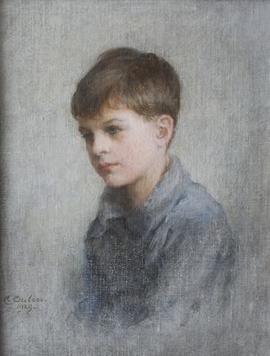Brock, Donald Alastair Carey, son of Capt. Donald Carey Brock CBE RN, of Guernsey, and his first wife Jocelyn Florence, d. of Admiral John Denison DSO RN, of Alverstoke, Hants; b. 7 Aug. 1919; adm. Sept. 1932 (A); left Dec. 1936; Cadet RN Jan. 1937, Sub.-Lieut. Apr. 1939, Lieut. July 1940; lost in HMS Bonaventure March 1941.
Donald Alastair Carey Brock was born at Alverstoke, Hampshire on the 7th of August 1919 the elder son of Captain Donald Carey Brock CBE RN and Jocelyn Florence (nee Denison) Brock of “Alvermead”, Alverstoke, Gosport, Hampshire and of 32, Troy Court, Kensington in London. He was educated at Westminster School where he was up Ashburnham from September 1932 to December 1936. During his youth he was a regular visitor to Canada, where his maternal grandparents lived; he spent his summers at Muskoka and was regarded as an expert swimmer.
He joined the Royal Navy as a Cadet on a special entry cadetship in January 1937 and was appointed as a Midshipman on the 1st of January 1938. He was commissioned as a Sub Lieutenant in April 1939 and was promoted to Lieutenant on the 16th of July 1940. He was posted to the crew of the light cruiser HMS Bonaventure (31).
Convoy GA-8 set sail from Piraeus in Greece on the night of the 29th of March 1941 bound for Alexandria. The convoy was made up of the transports HMS Breconshire and HMS Cameronia, escorted by three destroyers as part of Operation Lustre, the movement of Allied troops and supplies to reinforce Greece. HMS Bonaventure, under the command of Captain Henry Jack Egerton RN, joined the convoy at the dawn on the following day. At 8.37pm that night two torpedoes were fired at HMS Bonaventure by the Italian submarine Dagabur, under the command of Captain Domenico Romano, which missed her and exploded in open water.
At 3am on the morning of the 31st of March 1941 she was sailing in a south easterly direction midway between Crete and Alexandria, some 100 nautical miles to the south-south-east of Crete, when she was hit amidships by two torpedoes fired by the Italian submarine Ambra, under the command of Captain Mario Arillo. The explosion caused extensive flooding in both engine rooms and she sank in less than six minutes. The enemy submarine was heavily depth charged during seven attacks by the escort destroyer HMAS Stuart and after the second attack the submarine broke surface before crash diving. HMAS Stuart experienced a near miss from a torpedo which exploded in the water fifty yards off her stern as she ran in for one of her attacks.
Twenty three officers and one hundred and fifteen ratings had been killed in the attack with three hundred and ten men being rescued from the sea by HMAS Stuart and the escort destroyer HMS Hereward. The convoy reached Alexandria during the late afternoon without further incident.
He is commemorated on a memorial plaque at the Cathedral Church of St James, Toronto and on the war memorial at St John’s Cemetery on the Humber, Toronto.
He is commemorated on the Plymouth Naval Memorial Panel 44, Column 2.
